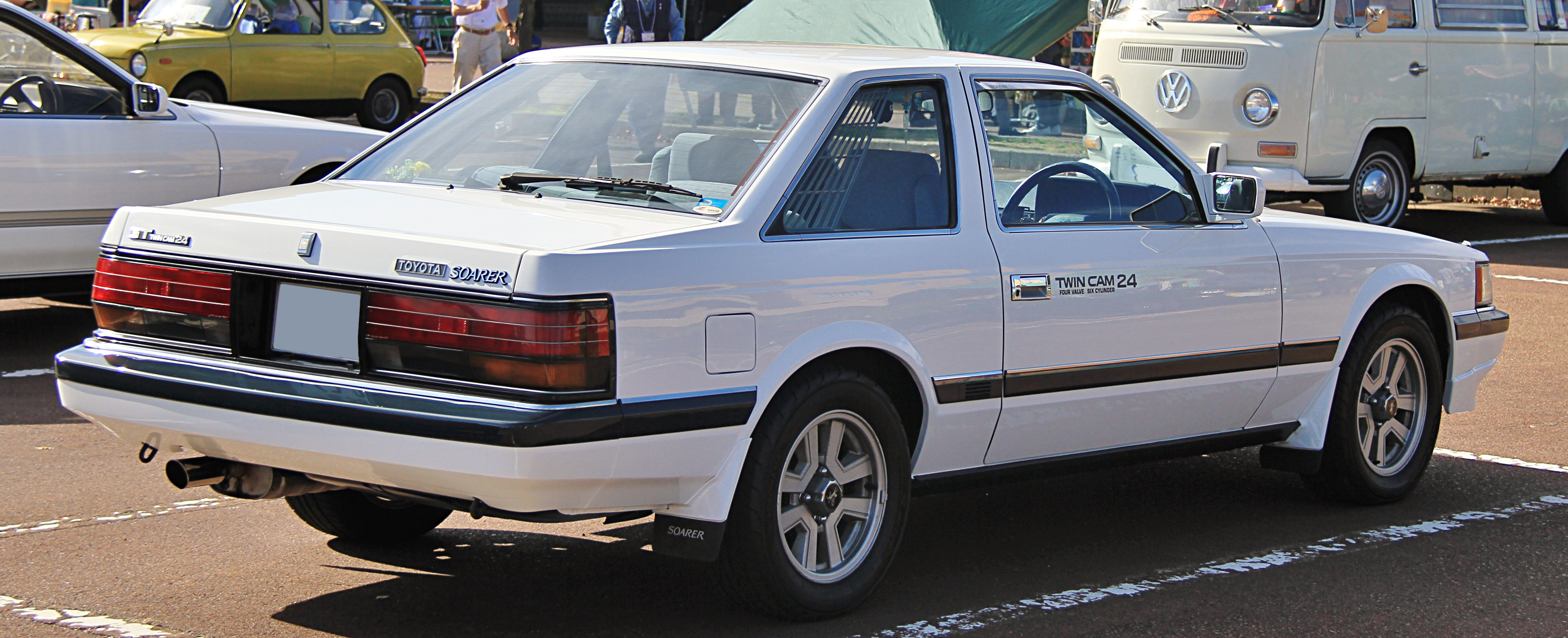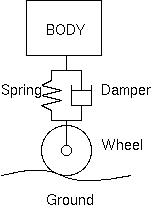|
Toyota Active Control Suspension
Toyota Active Control Suspension was (according to Toyota) the world's first fully active suspension. It was a complex hydropneumatic, computer-controlled active suspension system. This did away with conventional springs and anti-roll (stabiliser) bars in favour of hydraulic struts controlled by an array of sensors (such as yaw velocity sensors, vertical G sensors, height sensors, wheel speed sensors, longitudinal and lateral G sensors) that detected cornering, acceleration and braking forces. The system worked well and gave an unusually controlled yet smooth ride with no body roll. However, the additional weight and power requirements of the system affected straight-line performance somewhat. Introduced in September 1989 on the Japanese market only Toyota Celica ST183 GT-R Active Sports. Ten years later, Mercedes-Benz introduced a very similar active suspension, called Active Body Control, on the Mercedes-Benz CL-Class in 1999. Vehicles * Toyota Curren ST207 1994-1995 XS ... [...More Info...] [...Related Items...] OR: [Wikipedia] [Google] [Baidu] |
Toyota
is a Japanese multinational automotive manufacturer headquartered in Toyota City, Aichi, Japan. It was founded by Kiichiro Toyoda and incorporated on . Toyota is one of the largest automobile manufacturers in the world, producing about 10 million vehicles per year. The company was originally founded as a spinoff of Toyota Industries, a machine maker started by Sakichi Toyoda, Kiichiro's father. Both companies are now part of the Toyota Group, one of the largest conglomerates in the world. While still a department of Toyota Industries, the company developed its first product, the Type A engine in 1934 and its first passenger car in 1936, the Toyota AA. After World War II, Toyota benefited from Japan's alliance with the United States to learn from American automakers and other companies, which would give rise to The Toyota Way (a management philosophy) and the Toyota Production System (a lean manufacturing practice) that would transform the small company into a leader i ... [...More Info...] [...Related Items...] OR: [Wikipedia] [Google] [Baidu] |
Mercedes-Benz
Mercedes-Benz (), commonly referred to as Mercedes and sometimes as Benz, is a German luxury and commercial vehicle automotive brand established in 1926. Mercedes-Benz AG (a Mercedes-Benz Group subsidiary established in 2019) is headquartered in Stuttgart, Baden-Württemberg, Germany. Mercedes-Benz AG produces consumer luxury vehicles and commercial vehicles badged as Mercedes-Benz. From November 2019 onwards, Mercedes-Benz-badged heavy commercial vehicles (trucks and buses) are managed by Daimler Truck, a former part of the Mercedes-Benz Group turned into an independent company in late 2021. In 2018, Mercedes-Benz was the largest brand of premium vehicles in the world, having sold 2.31 million passenger cars. The brand's origins lie in Daimler-Motoren-Gesellschaft's 1901 Mercedes (marque), Mercedes and Carl Benz's 1886 Benz Patent-Motorwagen, which is widely regarded as the first internal combustion engine in a self-propelled automobile. The slogan for the brand is "the bes ... [...More Info...] [...Related Items...] OR: [Wikipedia] [Google] [Baidu] |
Vehicle Safety Technologies
A vehicle (from la, vehiculum) is a machine that transports people or cargo. Vehicles include wagons, bicycles, motor vehicles (motorcycles, cars, trucks, buses, mobility scooters for disabled people), railed vehicles (trains, trams), watercraft (ships, boats, underwater vehicles), amphibious vehicles (screw-propelled vehicles, hovercraft), aircraft (airplanes, helicopters, aerostats) and spacecraft.Halsey, William D. (Editorial Director): ''MacMillan Contemporary Dictionary'', page 1106. MacMillan Publishing, 1979. Land vehicles are classified broadly by what is used to apply steering and drive forces against the ground: wheeled, tracked, railed or skied. ISO 3833-1977 is the standard, also internationally used in legislation, for road vehicles types, terms and definitions. History * The oldest boats found by archaeological excavation are logboats, with the oldest logboat found, the Pesse canoe found in a bog in the Netherlands, being carbon dated to 8040 - ... [...More Info...] [...Related Items...] OR: [Wikipedia] [Google] [Baidu] |
Toyota Electronic Modulated Suspension
TEMS (Toyota Electronic Modulated Suspension) is a shock absorber that is electronically controlled (Continuous Damping Control) based on multiple factors, and was built and exclusively used by Toyota for selected products during the 1980s and 1990s (first introduced on the Toyota Soarer in 1983). The semi-active suspension system was widely used on luxury and top sport trim packages on most of Toyota’s products sold internationally. Its popularity fell after the “bubble economy” as it was seen as an unnecessary expense to purchase and maintain, and remained in use on luxury or high performance sports cars. Summary TEMS consisted of four shock absorbers mounted at all four wheels, and could be used in either an automatic or driver selected mode based on the installation of the system used. The technology was installed on top-level Toyota products with four wheel independent suspension, labeled PEGASUS (Precision Engineered Geometrically Advanced SUSpension). Because of the n ... [...More Info...] [...Related Items...] OR: [Wikipedia] [Google] [Baidu] |
Toyota Soarer
The is a Personal luxury car, personal luxury Grand tourer, GT coupé produced from 1981 to 2005 by Toyota and sold in Japan. It was available at both Japanese Toyota dealerships called ''Toyota Store'' and ''Toyopet Store'', and it debuted with the Z10 series, replacing the ''Toyopet Store'' exclusive Toyota Mark II (X30), Mark II coupé, and the ''Toyota Store'' exclusive Toyota Crown (S110), Crown coupé. In 1986, the Z20 series Soarer was launched, based on the then new Toyota Supra (A70), A70 series Supra platform. In 1991, the Z30 series Soarer premiered in Japan, while its Lexus equivalent, the Lexus SC (Z30), SC 300/400 debuted in the US market. While externally identical to the SC, the Z30 series Soarer lineup offered different powertrain specifications and multiple unique vehicle configurations. In 2001, Toyota introduced a convertible-only successor in Japan as the Z40 series Soarer and elsewhere as the Lexus SC (Z40), SC 430. In contrast to previous series, the Z40 s ... [...More Info...] [...Related Items...] OR: [Wikipedia] [Google] [Baidu] |
Toyota Curren
The is a sport compact coupé built by Toyota from 1994 to 1998. It is based on the T200 series Celica chassis. It shared the same interior and rear end design as the Celica coupé. Instead of having four round headlamps like the Celica, it has a rectangular headlamp design providing a more traditional halogen headlamp appearance. Modifying the appearance of the Celica allowed Toyota to sell the Curren at '' Toyota Vista Store'' locations, as the Celica was exclusive to ''Corolla Store'' locations. The Curren directly replaced the T160 series Corona Coupé, which was exclusive to ''Toyopet Store'' locations. The name "Curren" is derived from English word "current". Model history 1994–1995 In 1994, the Curren was available in two models, the ST206 and ST207. The ST206 model had four different trim levels. The FS, XS, ZS and ZS Sport Selection. The FS and XS trims were both powered by the 2.0 L '' 3S-FE'' engine, whereas the ZS trims were powered by the 2.0 L ... [...More Info...] [...Related Items...] OR: [Wikipedia] [Google] [Baidu] |
Mercedes-Benz C215
The second generation of the Mercedes-Benz CL-Class is the C215-chassis coupé of 1998–2006. It is based on the 1998–2005 Mercedes-Benz S-Class (W220), though it rides on an shorter wheelbase. Sales in Germany started in August 1999 for the CL 500 V8. The C215 exterior design and active suspension was previewed by the Mercedes-Benz F200 concept in 1996. The CL-Class is offered as seven models: the V8-powered CL 500, the V8 powered naturally aspirated CL 55 AMG, the supercharged V8-powered CL 55 AMG, the V12-powered CL 600, a V8-powered CL 63 AMG, and the bi-turbo V12-powering the CL 600 bi-turbo and the CL 65 AMG. All models seat four. Exterior design produced a for a regular models and 0.29 for AMG. Features and equipment The CL-Class coupés come equipped with the very latest in Mercedes-Benz technology, and along with the S-Class sedans the CL coupés receive new technological features. C215 was the second car (after the W220 S-Class) with Distronic: the firs ... [...More Info...] [...Related Items...] OR: [Wikipedia] [Google] [Baidu] |
Active Body Control
Active Body Control, or ABC, is the Mercedes-Benz brand name used to describe electronically controlled hydropneumatic suspension. This suspension combines a high level of ride quality with control of the vehicle body motions, and therefore virtually eliminates body roll in many driving situations including cornering, accelerating, and braking. Mercedes-Benz has been experimenting with these capabilities for automobile suspension since the air suspension of the 1963 ''600'' and the hydropneumatic (fluid and air) suspension of the 1974 ''6.9''. ABC was only offered on rear-wheel drive models, as all-wheel drive 4MATIC models were available only with ''Airmatic'' semi-active air suspension, with the 2019 Mercedes-Benz GLE 450 4MATIC being the first AWD to have ABC available. The production version was introduced at the 1999 Geneva Motor Show on the new Mercedes-Benz CL-Class C215. Description In the ABC system, a computer detects body movement from sensors located ... [...More Info...] [...Related Items...] OR: [Wikipedia] [Google] [Baidu] |
Toyota Celica
The is an automobile produced by Toyota from 1970 until 2006. The Celica name derives from the Latin word '' coelica'' meaning 'heavenly' or 'celestial'. In Japan, the Celica was exclusive to the '' Toyota Corolla Store'' dealer chain. Produced across seven generations, the Celica was powered by various four-cylinder engines, and bodystyles included convertibles, liftbacks, coupés and notchback coupés. In 1973, Toyota coined the term ''Liftback'' to describe the Celica fastback hatchback, and used the name ''Liftback GT'' for the North American market. Like the Ford Mustang, the Celica concept was to create a sports car by attaching a coupe body to the chassis and mechanicals from a high volume sedan, in this case the Toyota Carina. However, some journalists thought it was based on the Corona due to some shared mechanical parts. The first three generations of North American market Celicas were powered by variants of Toyota's R series engine. In August 1985 ... [...More Info...] [...Related Items...] OR: [Wikipedia] [Google] [Baidu] |
Active Suspension
An active suspension is a type of automotive suspension on a vehicle. It uses an onboard system to control the vertical movement of the vehicle's wheels relative to the chassis or vehicle body rather than the passive suspension provided by large springs where the movement is determined entirely by the road surface. Active suspensions are divided into two classes: real active suspensions, and adaptive or semi-active suspensions. While semi-adaptive suspensions only vary shock absorber firmness to match changing road or dynamic conditions, active suspensions use some type of actuator to raise and lower the chassis independently at each wheel. These technologies allow car manufacturers to achieve a greater degree of ride quality and car handling by keeping the tires perpendicular to the road in corners, allowing better traction and control. An onboard computer detects body movement from sensors throughout the vehicle and, using that data, controls the action of the active and semi-act ... [...More Info...] [...Related Items...] OR: [Wikipedia] [Google] [Baidu] |




.jpg)


